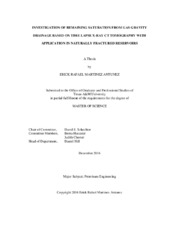| dc.description.abstract | Naturally fractured reservoirs (NFR) represent an important fraction of oil reserves in the world.In many of the NFR, significant volumes of oil have been or are expected to be recovered from the matrix due to the presence of the gas gravity drainage drive mechanism. Nonetheless, there are some uncertainties to accurately predict oil recovery factors and remaining fluid saturations due to this drive mechanism despite the existence of studies performed in the last three decades.
Several mathematical models for gravity drainage in NFR have been developed based on results obtained from laboratory experiments. However, these models have not provided accurate results in field applications. One of the reasons is that the experiments only considered an oil-gas system which in many cases is not a realistic assumption due to the presence of connate water in the reservoirs. Another reason is that, in some cases, heterogeneities, such as vuggy porosity, were ignored in both the experiments and the mathematical models.
Based on these considerations, two long-term experiments that mimicked gas gravity drainage in NFR were performed. The experiments were carried out with the purpose of acquiring data that might be used to improve current mathematical models or to develop new ones. During the experiments, time-lapse X-Ray CT images were acquired at different intervals with the objective of determining the fluids saturation along the core samples due gravity drainage. Additionally, oil produced was measured.
Experiment 1 was performed in an oil-brine-air system. A stack of six Berea sandstone core samples in capillary contact was used. Initially, the stack was saturated with oil at irreducible water saturation.
Experiment 2 was performed in an oil-air system. A one-piece of Edwards limestone core with primary and vuggy porosity core was used. At the initial condition, the core was saturated with oil. Due to the presence of vugs, a novel technique was developed to quantify porosity and oil saturation for the primary porous system and the vuggy porous system.
For both experiments, a good match between the measured oil produced and the remaining oil volume in the matrix estimated from the remaining fluids saturations obtained through the CT X-Ray images was observed. The techniques used in these experiments provide a new, unique and reliable method to study the important phenomenon of gas gravity drainage in NFR. | en |


